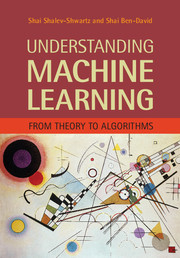Book contents
- Frontmatter
- Dedication
- Contents
- Preface
- 1 Introduction
- Part 1 Foundations
- Part 2 From Theory to Algorithms
- Part 3 Additional Learning Models
- 21 Online Learning
- 22 Clustering
- 23 Dimensionality Reduction
- 24 Generative Models
- 25 Feature Selection and Generation
- Part 4 Advanced Theory
- Appendix A Technical Lemmas
- Appendix B Measure Concentration
- Appendix C Linear Algebra
- References
- Index
22 - Clustering
from Part 3 - Additional Learning Models
Published online by Cambridge University Press: 05 July 2014
- Frontmatter
- Dedication
- Contents
- Preface
- 1 Introduction
- Part 1 Foundations
- Part 2 From Theory to Algorithms
- Part 3 Additional Learning Models
- 21 Online Learning
- 22 Clustering
- 23 Dimensionality Reduction
- 24 Generative Models
- 25 Feature Selection and Generation
- Part 4 Advanced Theory
- Appendix A Technical Lemmas
- Appendix B Measure Concentration
- Appendix C Linear Algebra
- References
- Index
Summary
Clustering is one of the most widely used techniques for exploratory data analysis. Across all disciplines, from social sciences to biology to computer science, people try to get a first intuition about their data by identifying meaningful groups among the data points. For example, computational biologists cluster genes on the basis of similarities in their expression in different experiments; retailers cluster customers, on the basis of their customer profiles, for the purpose of targeted marketing; and astronomers cluster stars on the basis of their spacial proximity.
The first point that one should clarify is, naturally, what is clustering? Intuitively, clustering is the task of grouping a set of objects such that similar objects end up in the same group and dissimilar objects are separated into different groups. Clearly, this description is quite imprecise and possibly ambiguous. Quite surprisingly, it is not at all clear how to come up with a more rigorous definition.
There are several sources for this difficulty. One basic problem is that the two objectives mentioned in the earlier statement may in many cases contradict each other. Mathematically speaking, similarity (or proximity) is not a transitive relation, while cluster sharing is an equivalence relation and, in particular, it is a transitive relation. More concretely, it may be the case that there is a long sequence of objects, x1, …, xm such that each xi is very similar to its two neighbors, xi−1 and xi+1, but x1 and xm are very dissimilar.
- Type
- Chapter
- Information
- Understanding Machine LearningFrom Theory to Algorithms, pp. 264 - 277Publisher: Cambridge University PressPrint publication year: 2014

